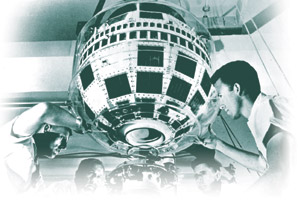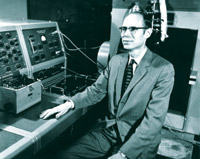| |
 |
Engineers make final adjustments to Telstar 1, the world’s first active, direct
relay communications satelliteBT/Vismedia
|
The start of satellite communications
Last month, we looked at how the first-ever live television broadcast
took place across an ocean. This time, we focus on the satellite that made it possible.
Telstar is a hit
In 1962, British music producer Joe Meek was inspired to compose a tune named
“Telstar.” But who made it into a hit record? We asked that question in the previous
issue of ITU News, and the answer is the UK band, the Tornados, who took
the instrumental to the top of the charts on either side of the Atlantic. The tune’s
popularity reflected the great excitement caused by the first live television broadcast
to take place between the United States and Europe, on 10 July that year, by means
of the satellite Telstar 1. Although nowadays, television viewers take for granted
that they can watch live footage of important events on the other side of the world,
44 years ago it truly captured people’s imaginations.
| A satellite pioneer
US engineer John R. Pierce (1910–2002) played a leading part in designing
Echo 1 and Telstar 1. Like Arthur C. Clarke, he was also a writer of science fiction.
|

NASA
|
|
Telstar 1 was owned by AT&T of the United States, and developed there by Bell
Telephone Laboratories. The project was also joined by the United States’ National
Aeronautics and Space Administration (NASA), the British General Post Office and
the French National Post and Telecommunications Office. Telstar was the world’s
first active, direct relay communications satellite. According to one of its designers,
John R. Pierce, the idea was to create a system of “between 50 and 120 simple active
satellites in orbits about 7000 miles (11 250 kilometres) high.” Global coverage
would be achieved by eventually having “40 satellites in polar orbits and 15 in
equatorial orbits (that) would provide service 99.9 per cent of the time
between any two points on Earth.”
As the first step in this programme, Telstar 1
was launched from Cape Canaveral in the United States. The satellite weighed 77.5
kilograms and was some 88 centimetres in diameter. Solar cells provided a little
under 15 watts of power. It could relay transatlantic signals for a maximum of 102
minutes per day, comprising either 500 telephone calls, or one television channel.
That was used for the first live television picture beamed across the Atlantic:
an image of an American flag at the Andover Earth Station that sent the transmission
from the United States. As well as expressing national pride at the achievement,
US President John F. Kennedy spoke of the need to “grasp the advantages presented
to us by the communications satellite to use this medium wisely and effectively
to ensure greater understanding among the peoples of the world.”
Following an echo
| |
.jpg)
NASA
|
Echo 1 comprised a thin, metalized balloon of 30.5 metres in diameter. Signals
were bounced off its surface, without amplification |
Telstar was not, in fact, the first satellite to be used for communications.
That honour goes to Echo 1, an experimental project by NASA developed in the late
1950s in conjunction with Bell Laboratories. Unlike Telstar, which amplified the
signals it received before relaying them, Echo was a passive satellite; that is,
signals were sent to it from Earth and simply bounced back off its surface to another
point on the planet. It consisted of a large balloon of about 30.5 metres in diameter,
made from 0.127-millimetre thick polyester film that had a shiny metal coating.
It was launched on 12 August 1960 from Cape Canaveral, and redirected radio, television
and telephone signals for eight years.
Echo 1 was visible to the naked eye all over the world. Arthur C. Clarke, who
first wrote about the potential of communication satellites, later recalled how
he used this visibility to impress some students in Sri Lanka. Following a lecture,
he led the group outside, having calculated when Echo would appear. “We had waited
only a few minutes when a brilliant star rose in the west, defying the astronomical
wisdom of the ages,” he wrote. “It moved at about the speed of a high-flying jet
and took a few minutes to reach the meridian. Then it started to descend into the
east — but long before it had reached the horizon, it suddenly began to fade. Within
seconds, it was gone… I am sure that none of my youthful audience ever forgot their
view of Echo 1, which was probably seen by more human eyes than any other artifact
in the history of the world.” *
Music circles the world
On 25 June 1967, satellite communications were truly introduced to the masses
with a two-hour television programme called “Our World” that used three
satellites to share live broadcasts from countries around the globe. Among the
performers to a worldwide audience of an estimated 600 million were the British
rock group, the Beatles. They did not perform “Telstar.” However, given the role
in fostering international understanding that it was hoped satellite
communications would play, the Beatles’ choice of a song to première at the
event was perhaps even more appropriate. Its title was “All you need is love.”
* “How the world was one”, Arthur C. Clarke
(New York 1992).
A question for next time:
Who coined the word “television” and when? The answer can be found in next month’s
Pioneers' page.
|
|


